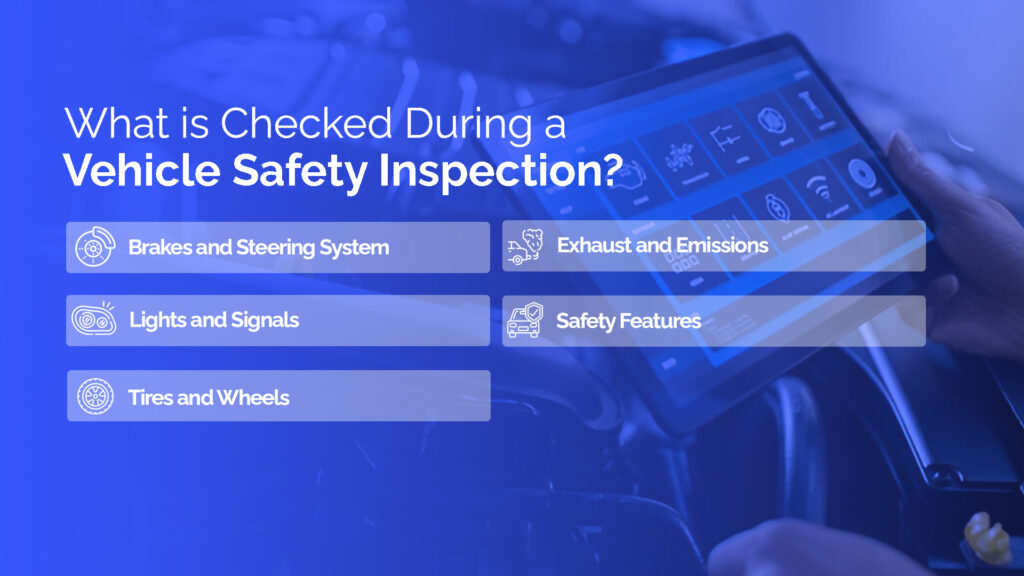Are you considering going on a road trip or buying a car soon? Whether a first-time buyer or an experienced fleet manager at a dealership, knowledge of the best vehicle inspection checklist goes a long way in achieving safety, reliability, and peace of mind. While some people and dealerships in the past may have neglected it, today, it has become an essential tool for their survival, at least in the high-competition regions. Let’s learn about vehicle inspection checklists, how they work, and how modern AI-based solutions help today’s dealerships achieve their goals.
What is a Vehicle Inspection Checklist, and What are its Types?
A vehicle inspection checklist is a comprehensive guide designed to evaluate a vehicle’s overall condition and safety. From the exterior of the car body to the internal components, a complete vehicle inspection checklist ensures that every part of the car is in the best condition. This tool is essential for personal and fleet vehicles, helping prevent accidents, reduce maintenance costs, and maintain legal standards.
There are various types of checklists, such as:
- Basic Vehicle Inspection Checklist: Covers essential checks like tires, lights, and fluid levels for routine maintenance.
- Vehicle Safety Inspection Checklist: This checklist focuses on safety-critical components like brakes, steering, and airbags to ensure the safety of drivers and passengers.
- Automotive Inspection Checklist: A more detailed version used by mechanics and auto safety inspectors to assess the overall mechanical and electronic systems.
- Comprehensive Inspection Checklist: In-depth evaluation that includes diagnostics, emissions, and advanced safety systems.
- Vehicle Audit Checklist: Used by fleet managers to monitor and maintain a fleet’s health, ensuring compliance and operational efficiency.
Whether for daily checks for commercial fleets or annual inspections required by regulatory bodies, having a complete vehicle inspection checklist guarantees that your vehicle remains safe, reliable, and legally compliant.

Why Should You Use a Vehicle Inspection Checklist
Using a car inspection checklist is crucial for maintaining safety, extending vehicle lifespan, and enhancing resale value. Here’s why it’s essential:
- Enhanced Safety and Accident Prevention:
Thousands of road accidents happen every year due to preventable mechanical failures like worn brakes, under-inflated tires, or malfunctioning lights. A vehicle safety inspection checklist helps identify potential issues before they become dangerous, ensuring the safety of drivers, passengers, pedestrians, and other road users. - Encourages Preventive Maintenance:
Regular use of a car safety inspection checklist promotes measures that keep vehicles in peak condition. This proactive approach enhances safety and reduces costly repairs and unexpected breakdowns, ultimately saving time and money. - Legal Compliance and Reduced Liability:
Many regions require periodic safety and emissions checks by law. Using a vehicle inspection safety checklist ensures compliance with these legal requirements, helping you avoid fines, penalties, or liability issues. It also contributes to environmental sustainability by maintaining emission standards. - Boosts Resale Value:
A well-maintained vehicle with a documented history of regular inspections using a general vehicle inspection checklist commands a higher resale value. Buyers are more likely to trust vehicles with consistent maintenance records, making them easier to sell at a better price. - Streamlined Fleet Management:
For businesses managing multiple vehicles, a vehicle audit checklist or auto safety inspection checklist helps maintain fleet safety and efficiency. It ensures that all vehicles are roadworthy, reducing downtime and enhancing productivity.
Critical Components of a Vehicle Inspection Checklist
A proper safety inspection checklist for cars involves many critical components. Let’s break it down and understand why this is so important:
Brake Test
The braking vehicle inspection systems, perhaps, is the most important safety feature in any car. Brakes allow one to decelerate from high speed; hence, any failure in brakes anywhere can be disastrous. An automotive safety inspection checklist covers the wear and tear of brake pads, damages/warping of rotors, and brake fluid levels and leaks.
Tires
Tires are the only part of your vehicle that touches the ground. The friction of the road to the tire impacts grip, stability, and handling. A checklist for vehicle safety inspection ensures there is sufficient tread depth; uniform tread wear patterns, and sufficient tire pressure.
Tires can become both under-inflated or over-inflated. Either can adversely affect both fuel efficiency as well as vehicle control.
Lights and Signals
Lights and signals are essential for one to be seen and even communicate with other road users, especially at night or when the weather is unfavorable. All your lights, whether headlights, taillights, brake lights, turn signals, and hazard lights, should be functional. Check all the light covers for any cracks or condensation; replace any bulb that burnt out.
Steering and Suspension
Steering and suspension systems keep your vehicle stable and controllable. Any fault in these systems becomes hazardous to handle. A safety inspection checklist for vehicles will check the wheel for excessive play or vibration and other parts like tie rods, ball joints, and shock absorbers for wear and tear.
Emissions
Many regions have stringent emissions laws to minimize air pollution. Vehicles are allowed on the road only if they pass emissions testing. A good safety inspection checklist will use specialized tools to measure the levels of pollutants emitted by the car. If emissions are too high, you may need to fix or replace parts of the exhaust system or tune the engine to reduce emissions.
Fluid Levels
Different fluids keep your car running and smooth by lubricating and cooling all of its parts. Low levels of these fluids can have your engine overheating or your brakes failing, especially causing problems with your transmission. A good multipoint vehicle inspection ensures the proper level, cleanliness, and non-contamination of each fluid, which could prevent serious damage to your engine and the overall health of your vehicle.
Battery and Electrical System
Essential for starting your vehicle and powering lights, wipers, etc., one should check the battery for any corrosion on terminals, see if it’s properly mounted, and is at a sufficient charge. An automotive vehicle inspection checklist would conduct all electrical connection tests focusing on power windows, interior lights, dashboard gauges, etc.
Windshield and Wipers
The windshield provides structural support to the car and clear visibility to the driver, whereas wipers provide clear visibility in the rain or snow. A checklist inspects your windshield for any chips or cracks that might deteriorate over time. Additionally, it inspects the wipers to see if they clear well and check the wiper fluid.
Exhaust System
The exhaust system eliminates harmful fumes, helps reduce engine noise, and prevents hazardous gases from entering the cabin. A faulty exhaust system may impact your vehicle’s performance and pose health issues for its users. A free vehicle inspection checklist would check for rusting, damages, and leaks on the exhaust pipes and muffler.
Pre-Inspection Preparation
Pre-inspection preparation is crucial for an efficient and thorough vehicle check. By organizing the necessary tools and setting up the proper workspace, you ensure a smoother inspection process. Here’s how to get started:
Collect Essential Tools and Materials
To effectively use a vehicle inspection checklist, having the right tools on hand is essential. Whether you’re following a basic vehicle inspection checklist or a comprehensive inspection checklist, these tools will help you perform a detailed and accurate assessment:
- Common Tools: Include a flashlight, screwdrivers, tire pressure gauge, and a jack. These are essential for checking basic components like lights, tires, and undercarriage parts.
- Diagnostic Tools: An OBD-II scanner helps read engine codes and diagnose potential issues. This tool is vital for completing an automotive inspection checklist accurately.
- Safety Gear: Gloves and safety glasses are crucial for personal protection during inspection. These tools ensure that even minute components are examined safely.
Prepare the Correct Workspace
Creating a safe and efficient workspace is as important as the tools themselves. Proper preparation allows you to follow a vehicle safety inspection checklist systematically without interruptions:
- Lighting: Use bright, portable lamps to illuminate hard-to-reach areas. Proper lighting is essential for spotting leaks, corrosion, or damage.
- Space: Ensure the workspace is clean, flat, and free of obstacles. This setup allows easy access to all sides of the vehicle, speeding up the inspection and helping identify even minor flaws.
Manual Inspection vs. AI-Powered Vehicle Inspection
Traditional vehicle inspection methods involve a detailed manual check, which, although thorough, can be time-consuming and prone to human error. However, the automotive industry is evolving, and AI-powered tools are changing the inspection landscape.
Manual Inspection:
- Involves using a car inspection checklist to manually check each component, from lights to brakes to undercarriage.
- Requires a high level of expertise and attention to detail.
- Time-consuming and susceptible to human error or oversight.
AI-Powered Inspection:
- Utilizes advanced tools that integrate with a vehicle inspection safety checklist to automatically scan and assess vehicle components.
- AI technology enhances accuracy and speed, reducing human error.
- Companies like Spyne offer AI-driven comprehensive inspection checklists that ensure no detail is missed.
Using an AI-powered auto safety inspection checklist can streamline the process while providing more accurate and reliable results.
10 Things to Check While Performing a Vehicle Inspection Checklist in 2025
Performing a thorough vehicle inspection is crucial for safety, performance, and maintaining the vehicle’s value. To ensure a complete and accurate assessment, make sure your vehicle inspection checklist includes the following key components:
1. Tires and Wheels
- Tire Pressure: Check and adjust tire pressure to the recommended levels for optimal handling and fuel efficiency.
- Tread Depth: Measure tread depth to ensure safe traction and avoid hydroplaning.
- Wheel Alignment and Balance: Inspect for proper alignment and balance to prevent uneven wear and improve driving stability.
2. Brakes
- Brake Pads and Rotors: Examine brake pads for thickness and check rotors for warping or damage.
- Brake Fluid Levels: Ensure the brake fluid is at the recommended level and free from contamination.
- Brake Lines and Hoses: Look for any signs of leakage or wear.
3. Lights and Signals
- Headlights and Taillights: Confirm that all lights function correctly for safe visibility.
- Brake Lights and Indicators: Check turn signals, hazard lights, and brake lights to ensure they are working properly.
- Fog Lights and Reverse Lights: Test auxiliary lights for additional safety during adverse weather conditions.
4. Engine and Transmission
- Diagnostic Scan: Use an OBD-II scanner to check for any diagnostic trouble codes.
- Fluid Leaks and Levels: Inspect for any leaks around the engine and check all fluid levels, including engine oil and transmission fluid.
- Noise and Vibration: Listen for unusual noises and feel for vibrations during engine operation.
5. Battery and Electrical Systems
- Battery Charge and Terminals: Verify that the battery is fully charged and check for corrosion on terminals.
- Electrical Connections: Inspect all wiring and connections for wear or damage.
- Alternator and Starter: Test the alternator’s charging capacity and the starter’s efficiency.
6. Fluid Levels
- Engine Oil: Check the oil level and condition to ensure proper lubrication.
- Transmission Fluid: Inspect the fluid level and color for signs of contamination.
- Brake Fluid, Coolant, and Windshield Washer Fluid: Verify that all essential fluids are topped off and in good condition.
7. Suspension and Steering
- Shock Absorbers and Struts: Look for signs of leaking or wear, which can impact ride comfort and safety.
- Steering Components: Check for looseness or play in steering joints and linkages.
- Alignment and Handling: Test for proper alignment and smooth steering response.
8. Exhaust System
- Leaks and Damage: Inspect exhaust pipes, muffler, and catalytic converter for leaks, rust, or damage.
- Emissions Compliance: Confirm the exhaust system meets local emission standards.
- Noise Levels: Ensure the exhaust noise levels are within legal limits.
9. Body and Frame
- Exterior Condition: Look for dents, scratches, rust, or paint damage.
- Structural Integrity: Check the undercarriage and frame for cracks, bends, or other structural issues.
- Windshield and Windows: Inspect for cracks, chips, or improper sealing.
10. Interior and Safety Equipment
- Seatbelts and Airbags: Verify that all seatbelts are functioning and airbags are in good working order.
- Dashboard Warning Lights: Confirm that all warning lights illuminate and turn off correctly.
- HVAC and Comfort Systems: Test the heating, ventilation, and air conditioning systems for proper operation.
What is Checked During a Vehicle Safety Inspection?
A vehicle safety inspection checklist focuses on essential safety components to ensure that the vehicle is roadworthy. It typically includes:

- Brakes and Steering System: Confirms that brakes respond promptly and steering is smooth without unusual noises.
- Lights and Signals: Ensuring all lights and indicators are functional for safe driving.
- Tires and Wheels: Checking for proper tire pressure, tread depth, and wheel alignment.
- Exhaust and Emissions: Verifying that the vehicle meets emission standards and the exhaust system is free of leaks.
- Safety Features: Confirm that airbags, seatbelts, and other safety devices are operational.
Using a vehicle inspection safety checklist or auto safety inspection checklist helps to systematically check these components and ensure the vehicle complies with safety regulations.
Why Select an AI Vehicle Inspection Checklist?
An AI-based 3rd party vehicle inspection offers a host of benefits over traditional methods:
- Speed and Efficiency: AI algorithms scan photos and videos of the automobile to find damage and trouble spots quickly. This saves time per inspection.
- Accuracy: The margin of error here is significantly reduced. Issues like hairline cracks and minor dents are easier to identify than during a physical inspection.
- Fraud detection: Advanced AI systems have the ability to detect traces of tampering or past damages that have been concealed behind. They analyze visual cues to identify any fraudulent practices.
- Comprehensive Coverage: AI inspections use multiple cameras and angles to ensure every part of the vehicle is examined, leaving no room for oversight.
- Cost Savings: Reducing manual labor and minimizing errors saves time and money for both inspectors and vehicle owners. It’s a cost-effective solution, especially for fleet management.
- Integration Data: Artificial intelligence systems tend to integrate well with other digital products. They ensure easy documentation and reporting. Thus, it improves communication, decision-making, and execution among individuals in business environments.
How can Spyne Help in Vehicle Inspection Checklists?
Spyne is an AI inspection technology firm that streamlines, making vehicle inspection easier and more streamlined. Here is how:
- Spyne’s advanced technology scans high-resolution images and videos to identify dents, scratches, and other damages. This enables detailed reports with visual evidence, making it easier to assess the condition of a vehicle.
- With Spyne, you can generate detailed vehicle inspection reports in minutes with images, damage assessments, and repair recommendations.
- Spyne’s algorithms can detect frauds, such as hidden damages or modified vehicle parts. This is very important for insurance companies and businesses that own huge vehicle fleets.
- Spyne is intuitive, so the end-user who doesn’t understand AI technology will not have any problems operating or completing the inspection process.
- Spyne can directly integrate inspection results with online marketplaces or maintenance scheduling systems for efficient business operations.
Conclusion
A complete vehicle inspection checklist is not an empty formality but is necessary to ensure driving safety and increase the lifespan of the vehicle. Whether it’s brake checks or fluid system inspections, regular check-ups save lives, reduce costs, and increase the general reliability of a vehicle. Innovations such as Spyne’s AI-based tools change the traditional way of car inspection, making it faster, more accurate, and more cost-effective.
Whether you’re a car owner, fleet manager, or involved in the auto industry, it’s crucial to know and carry out an all-rounded checkup process for a vehicle as a measure of investment into safety and performance. Take charge of your vehicle’s health today and secure a safer tomorrow.



























